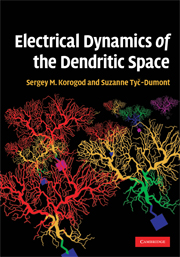Book contents
- Frontmatter
- Contents
- Preface
- 1 Definition of the neuron
- 2 3D geometry of dendritic arborizations
- 3 Basics in bioelectricity
- 4 Cable theory and dendrites
- 5 Voltage transfer over dendrites
- 6 Current transfer over dendrites
- 7 Electrical structure of an artificial dendritic path
- 8 Electrical structure of a bifurcation
- 9 Geography of the dendritic space
- 10 Electrical structures of biological dendrites
- 11 Electrical structure of the whole arborization
- 12 Electrical structures in 3D dendritic space
- 13 Dendritic space as a coder of the temporal output patterns
- 14 Concluding remarks
- Index
5 - Voltage transfer over dendrites
Published online by Cambridge University Press: 03 May 2010
- Frontmatter
- Contents
- Preface
- 1 Definition of the neuron
- 2 3D geometry of dendritic arborizations
- 3 Basics in bioelectricity
- 4 Cable theory and dendrites
- 5 Voltage transfer over dendrites
- 6 Current transfer over dendrites
- 7 Electrical structure of an artificial dendritic path
- 8 Electrical structure of a bifurcation
- 9 Geography of the dendritic space
- 10 Electrical structures of biological dendrites
- 11 Electrical structure of the whole arborization
- 12 Electrical structures in 3D dendritic space
- 13 Dendritic space as a coder of the temporal output patterns
- 14 Concluding remarks
- Index
Summary
Dendrites as electrical systems with distributed parameters differ from electrical systems with lumped parameters in an important aspect: any dendritic site can be considered as either input or output or both. In that sense, we deal with an electrical system such that the inputs and outputs are distributed in space, over the whole dendritic space.
The voltage is a standard and direct indicator of electric states. Similarity or dissimilarity of voltages reflects similarity or dissimilarity of electric states at different locations in space. The sign and magnitude of the voltage, that is the difference in the transmembrane potential between the sites, determines what electrically communicates with what and the intensity of the sent/received signals. The sites communicate by sending/receiving charges, i.e. by currents. The current flows in the direction of the voltage drop. Hence, considering the path profiles of the transmembrane voltage, one can see from where and to where the current flows in the given domain. Given the core resistance of the dendritic cable, the current between neighbouring sites is proportional to the voltage difference. Since one cannot ‘observe’ the path map of resistances, the path map of the voltages is informative, however not exhaustively. For an exhaustive characterization of the electric states and of the electric communication between sites over the dendritic space, a complementary map of the membrane currents is required (see Chapter 6).
Dendritic cables in the steady state
In the steady state, there are no temporal changes in voltage, voltage-sensitive conductance and current. The time derivatives of all values are zero. Therefore the capacitive current is zero.
Information
- Type
- Chapter
- Information
- Electrical Dynamics of the Dendritic Space , pp. 59 - 64Publisher: Cambridge University PressPrint publication year: 2009
